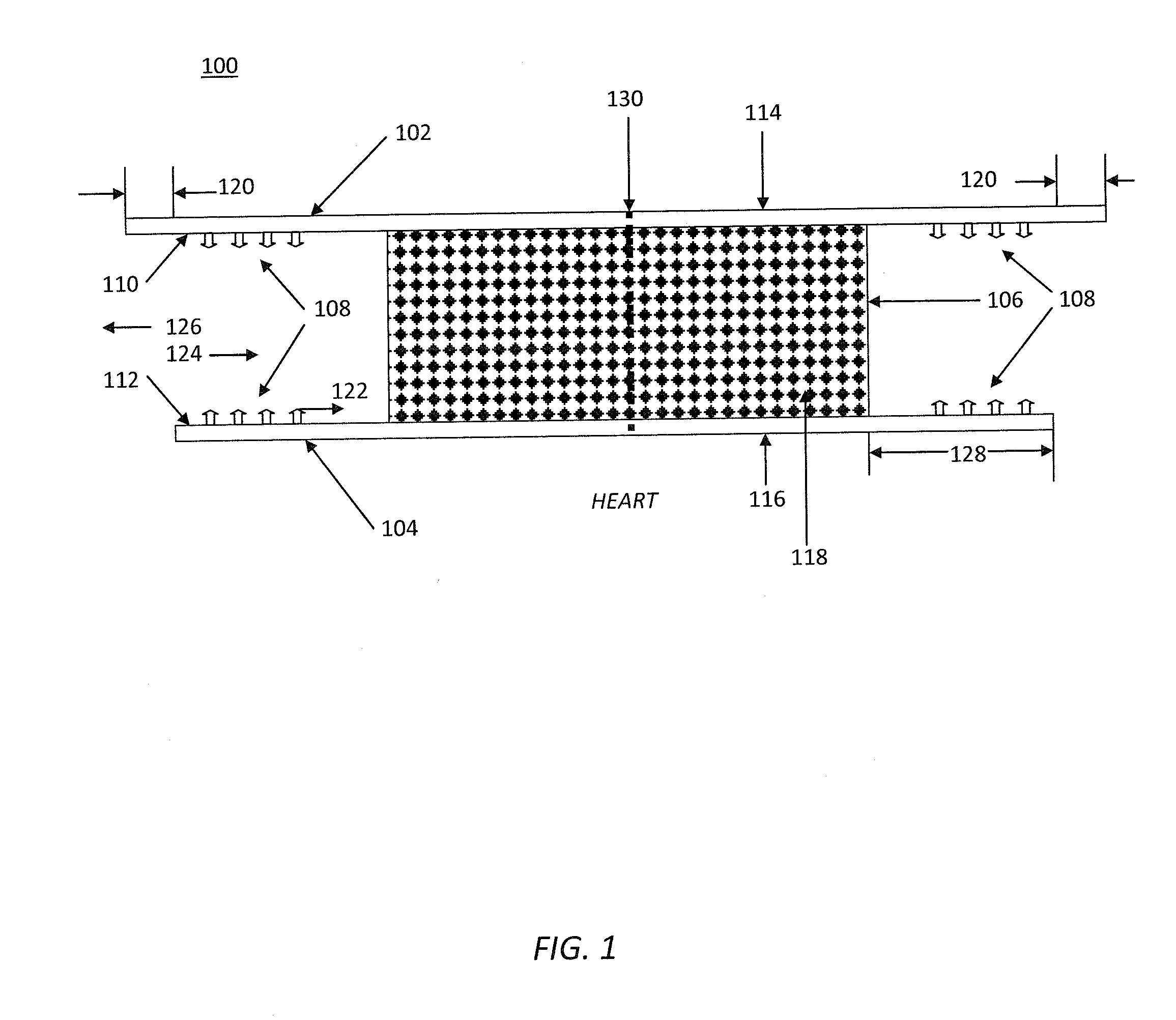Adhesion-Resistant Surgical Access, Reinforcement and Closure Prosthetic
a surgical access and prosthetic technology, applied in the field of medical implants, can solve the problems of affecting the healing process, and causing excessive or clinically unacceptable scar tissue or fibrosis, and achieves the effects of minimizing the proliferation of fibrosis, facilitating healing, and facilitating healing
- Summary
- Abstract
- Description
- Claims
- Application Information
AI Technical Summary
Benefits of technology
Problems solved by technology
Method used
Image
Examples
example 1
[0077]Referring to FIG. 1, a closure prosthetic 100 is comprised of an absorbable distal layer 102, an absorbable proximal layer 104, a sandwiched tissue scaffold layer 106, and attachment means 108. The attachment means 108 are located on distal interior side 110 of layer 102 and proximal interior side 112 of layer 104. Layers 102 and 104 have exterior distal sides 114 and exterior proximal sides 116, respectively. Sides 114 and 116 are smooth and resist tissue attachment. Layers 102 and 104 are bonded to opposite sides of tissue scaffold layer 106. Tissue scaffold layer 106 is a porous, flexible medium. The pores 118 are interconnected and sufficiently large and numerous to allow cells to infiltrate and tissue to grow into the tissue scaffold layer 106. Distal layer 102 is slightly larger than proximal layer 104, and both layers 102 and 104 are larger than tissue scaffold layer 106. The layers are bonded together in this arrangement, thereby defining a margin 120. Margin 120 allow...
example 2
[0081]Referring now to FIGS. 4A and 4B, a closure prosthetic 400 is shown with pre-folded proximal layer 104 in FIG. 4A. Edges 402 possess a proximally directed lip 404, as illustrated in FIG. 4B. Between edges 402 is defined the locus of incision such that when incision 406 is made, incision edges 408 naturally open and pass beyond lips 404 to position 410. Now when a dilator (not pictured) is placed in incision 406 proximal layers 104 unfolds. The fold in proximal layer 104 can be manufactured such that it is bistable, and can reside in either the fully folded position or the fully open position such that no matter the degree of dilation of incision 406 proximal layer 104 of closure prosthetic 400 becomes fully open.
[0082]Alternatively, the substance of proximal layer can be hydrophilic and induced to swell when in contact with bodily fluids such that shortly after incision 406 is made the swelling of proximal layer 104 causes it to assume the fully open position.
Closure Prostheti...
example 3
[0083]Referring now to FIG. 5, a closure prosthetic 500 is illustrated that includes inversion pulls 502. An incision 504 is made in tissue layer 506 and incision 504 naturally opens. Proximal layer 104 is naturally in the open position. To cause it to fold toward the incision opening, pulls 502 are pulled in direction 508. Proximal layer edges 508 engage incision edges 510 and slide proximally around them, causing tissue layer 506 to be sandwiched between distal layer 102 and proximal layer 104.
Closure Prosthetic
PUM
 Login to View More
Login to View More Abstract
Description
Claims
Application Information
 Login to View More
Login to View More - R&D
- Intellectual Property
- Life Sciences
- Materials
- Tech Scout
- Unparalleled Data Quality
- Higher Quality Content
- 60% Fewer Hallucinations
Browse by: Latest US Patents, China's latest patents, Technical Efficacy Thesaurus, Application Domain, Technology Topic, Popular Technical Reports.
© 2025 PatSnap. All rights reserved.Legal|Privacy policy|Modern Slavery Act Transparency Statement|Sitemap|About US| Contact US: help@patsnap.com



